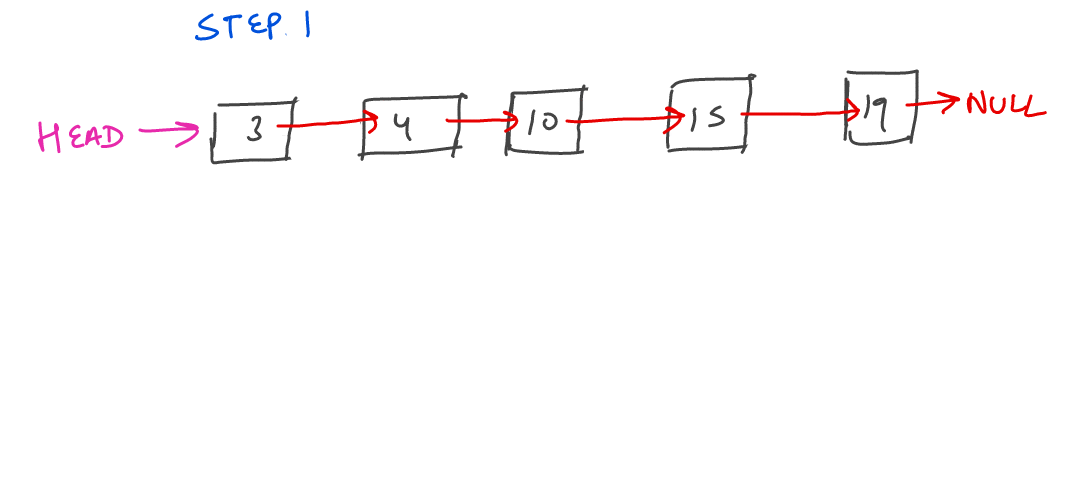Similar Problems
Similar Problems not available
Rotating a singly linked list - Leetcode Solution
Companies:
LeetCode: Rotating a singly linked list Leetcode Solution
Difficulty: Unknown
Topics: linked-list
Given a singly linked list and a number k. (k can be larger than n) Rotate the linked list k times.
Example Test Cases
Sample Test Case 1
Input Linked List: 3 -> 4 -> 10 -> 2 -> 15 ->19
K: 1
Expected Output: 19 -> 3 -> 4 -> 10 -> 2 -> 15
Explanation: This is because after 1 rotation 19 will come to the forward
Sample Test Case 2
Input Linked List: 3 -> 4 -> 10 -> 2 -> 15 ->19
K: 2
Expected Output: 15 -> 19 -> 3 -> 4 -> 10 -> 2 ->15
Explanation: This is because:
- After 1st rotation Linked List will become:
19 -> 3 -> 4 -> 10 -> 2 -> 15 - After 2nd rotation Linked List will become:
15 -> 19 -> 3 -> 4 -> 10 -> 2
Solution
If we observe carefully, we will notice two things :
- Rotating a list n times becomes brings it back to it’s original form. Therefore, even if k is larger than n, we can just rotate the list k%n times and it will still print the same output. for example if
n = 5, k = 1andn = 5 and k = 6will end up rotating the list in the same way. So it is better to rotate the list6%5 = 1times instead of 6. - Rotating the list
ktimes can be done by just rewiring the original linked list (changing the pointers for few of the nodes), instead of actually deleting elements from the end and inserting at the front. See the below diagram for better understanding
Rewiring
Rewiring the list can be done in the following steps
- Step 1: First calculate the length of the linked list. Let it be
n. Also dok = k%n. To make sure thatk < ngoing forward. In this case,n = 5, k = 2. - Step 2: Find the last node at index
(n - 1)and the node which will become the last node after rotation. Let us call that nodebefore. It will be located at indexn - 1 - k - Step 3: Make the last node’s
next pointerpoint towards the first node - Step 4: Change the
headto point to the node pointed to bybefore. This way we are able to change the starting node of the linked list - Step 5: Make the
beforenode point to NULL, since thebeforenode will become last in the final output.
See the below images for the visualization of the whole process: 
Rotating a singly linked list Solution Code
1#include <iostream>
2using namespace std;
3
4typedef struct node {
5 int val;
6 node* next;
7} node;
8
9int findSizeOfList(node* head) {
10 node* curr = head;
11 int size = 0;
12 while (curr != NULL) {
13 size++;
14 curr = curr->next;
15 }
16 return size;
17}
18
19// Gives the nth node of the linked list.
20node* findNode(node* head, int n) {
21 node* curr = head;
22 for(int i = 0; i < n; i++) {
23 curr = curr->next;
24 }
25 return curr;
26}
27
28// Helper method
29void printLinkedList(node* head) {
30 node* curr = head;
31 while (curr != NULL) {
32 cout << curr->val << " ";
33 curr = curr->next;
34 }
35 cout << "\n";
36}
37
38// Helper method
39void insertAtTheEnd(node** head, int val) {
40 node* newNode = new node;
41 newNode->val = val;
42 newNode->next = NULL;
43 if (*head == NULL) {
44 *head = newNode;
45 }
46 else {
47 node* curr = *head;
48 while (curr -> next != NULL) {
49 curr = curr->next;
50 }
51 curr->next = newNode;
52 }
53}
54
55void rotateRight(node** head, int k) {
56 int n = findSizeOfList(*head);
57 // After n rotations we get the same list, so rotating n + 1 times is same as rotating 1 time.
58 int newK = k%n;
59 if (newK > 0) {
60 // Last element after rotation
61 node* before = findNode(*head, n - 1 - newK);
62 // Current last node
63 node* lastNode = findNode(*head, n - 1);
64
65 // Step 3
66 lastNode->next = *head;
67 // Step 4
68 *head = before->next;
69 // Step 5
70 before->next = NULL;
71 }
72}
73
74int main() {
75 // Constructing the list
76 node* head = NULL;
77 insertAtTheEnd(&head, 3);
78 insertAtTheEnd(&head, 4);
79 insertAtTheEnd(&head, 10);
80 insertAtTheEnd(&head, 15);
81 insertAtTheEnd(&head, 19);
82
83 cout << "Printing before rotation\n";
84 printLinkedList(head);
85
86 rotateRight(&head, 2);
87
88 cout << "Printing after rotation\n";
89 printLinkedList(head);
90 return 0;
91}